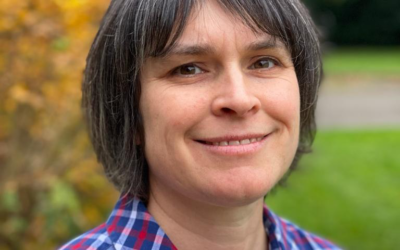Dr Janet Gray on some of the painful conditions that can benefit from homeopathy
In general practice, I was frequently consulted by people with problems with their joints. In any one surgery, I would quite likely see two or three such patients, whose problems could vary from a simple joint sprain to severe deformity due to rheumatoid arthritis.
In between these extremes come the many patients who have developed pain in a particular joint, which does not resolve with simple measures. It is important, first of all, to find out the “agenda” of the patient, or else one can find that the patient goes out dissatisfied, whatever you do. One of the most frequent worries of patients with joint pains is that they are getting arthritis. I can remember several patients consulting me over the years with fairly trivial joint problems, and I could not understand their apparent over-reaction until I discovered the underlying worry. Often a parent or close relative would have suffered from severe, incapacitating arthritis, and the patient was terrified that this was the first sign. They were envisaging ending up in a wheelchair in the near future. Very often it was possible to dispel these fears completely by close examination of the joint or by x-ray. Once the patient was reassured that the symptoms were not those of arthritis, they no longer worried about the slight discomfort.
What is arthritis ?
The word comes from the Greek arthros, meaning joint, and itis, meaning inflammation. So arthritis simply means inflammation of the joint. It is, therefore, an incomplete diagnosis, and this is where the problems arise. There are many different forms of arthritis, and each has a different clinical course and prognosis. So when a patient says to me, “Of course, my mother had arthritis.” I have to try to find out what sort she had, and whether it is likely to be hereditary.
Osteoarthritis (OA)
This is the most common form of arthritis. It is caused by the degeneration of the cartilage that covers the ends of the bones, where they “articulate” with other bones. When the cartilage wears away, there is bone grating on bone, which is obviously very painful, and limits the mobility of the joint. In addition, projections of bone, called osteophytes, grow out around the joint, causing swelling and sometimes trapping nerves.
OA was not thought to be hereditary but recent research has changed the thinking about this, and it is now thought that OA can cluster in families. It is not a generally progressive disease, so the patient can be reassured that it will not usually spread to involve other joints. It was previously thought that it was only a mechanical degeneration of the joint due to wear-and-tear, because it is usually seen in joints that have been over-used, or previously injured, but the recognition of genetic factors has introduced the idea that it is an active disease process.
Most elderly people suffer from OA of the knees as they get older, particularly if they are overweight, which is not surprising, because the knees have transported all the body’s weight for many years. It is worse in people who have spent a long time on their knees, for example carpenters, cleaners, and also in runners and footballers.
OA of the hip also occurs in athletes, especially gymnasts and dancers, who have over-stretched the joint. Before the days of hip replacement it was a common cause of elderly people being bent over a zimmer frame, walking slowly in extreme pain. Nowadays, although we complain about the waiting lists, OA of both hip and knee can be corrected by replacement surgery.
Other joints can also be affected by OA, for example the base of the thumb in hairdressers, because of continual use of scissors, the base of the big toe in policeman and traffic wardens, who are on their feet all day long. OA of the shoulders is a particular problem, as it is not so amenable to surgery, so is difficult to treat. It is very painful and so can cause big problems for those who have to do a lot of heavy lifting. However it is now clear that OA only develops in people with a genetic predisposition despite years of over-straining of that joint.
The joints affected by OA become stiff and painful, often creaking or grinding when being moved. There may be some swelling, but the joint is not usually hot or inflamed. The range of movement becomes less and less, restricting function, which is further restricted by the pain. Diagnosis is by clinical examination and x-ray. There are no changes in blood tests.
Rheumatoid arthritis (RA)
On the other hand, RA is a condition that definitely runs in families, and does have a progressive course, sufferers sometimes ending up with crippling disease of many joints.
It is an auto-immune disease, which means that the body is attacking its own joints. The reason for this is uncertain, but some researchers think the disease may be started by a viral infection.
The onset of RA is sometimes very acute, accompanied by an acute febrile illness, involving redness and swelling of one or more joints. When the fever settles, the joint remains painful and swollen, and other joints often become affected. Sometimes the disease seems to jump from joint to joint, with one clearing up and another being affected immediately (known as palindromic arthritis).
More frequently the onset is insidious, presenting with pain in the small joints of the fingers or toes. These joints swell and become deformed, ending up with the typical rheumatoid picture of ulnar deviation. Other joints are also affected, commonly shoulders, knees, ankles and elbows.
This is the form of arthritis that everyone dreads, but fortunately there are now more effective early drug interventions that can prevent the crippling deformities. They can, however, cause major side-effects. The use of homeopathy can reduce the need for such drugs, or at least reduce the dosage needed.
RA is diagnosed by blood tests and x-rays, and the progress of the disease can also be monitored with blood tests.
Psoriatic arthritis
This is very similar to rheumatoid arthritis, but is seen in patients who suffer from the skin disease, psoriasis. The blood tests for RA are negative, so the diagnosis is clinical.
Ankylosing spondylitis
This is a most unpleasant form of arthritis which predominantly hits young men between the age of 20 and 40. It is hereditary, and can be diagnosed by a blood test to detect a particular antigen called HLA-B27, and is again an autoimmune disease.
It mainly attacks the large sacro-iliac joints in the lower back, and if not treated can cause fusion of the joints, causing the patient to become bent over and fixed.
The mainstay of treatment, apart from drugs, is physiotherapy to keep the back supple.
Gout
Gout is caused by an excess of uric acid in the blood, which deposits itself in the joints. This is not due to over-indulgence in wines and port, as was previously thought! The uric acid crystals set up inflammatory reactions in the joints, causing extreme pain, tenderness, swelling, redness and heat. It usually affects the big toe, but can affect other joints.
It is treated conventionally with drugs to lower the uric acid level in the blood, but homeopathic treatment can also be very successful.
Septic arthritis
Other joint problems can be caused by infections and these are very serious. They have to be treated promptly with intra-venous antibiotics or else permanent damage will occur. The worst sort is tuberculous arthritis, not seen nearly so much these days but unfortunately showing a resurgence.
Homeopathic treatment
Although it is absolutely necessary to make an accurate diagnosis of the type of arthritis for the general management of the patient, from a homeopathic point of view it is the symptoms that are important.
So, if a patient is suffering from joint pains, worse on waking in the morning with great stiffness; better on limbering up after a while; better for a hot bath or shower; generally better in the hot dry weather, and worse in the cold and damp; worse on over-activity, but stiffens quickly on resting – that patient will require Rhus toxicodendron whatever the pathology, especially if the patient is restless, and unable to stay in bed because of the pain. Ruta graveolens has identical modalities to Rhus toxicodendron, but has more a predilection to tendons and ligaments, rather than joints. However it can be useful for arthritis, particularly of the knees, where Rhus toxicodenron has been seemingly well indicated but has failed to act.
If, however, the sufferer prefers the cold weather, and the joints are so painful that they dare not move them, even splinting them to keep them still, they will require Bryonia.
The symptoms of gout are often characterised by an exquisite sensitivity to touch, such that the patient cannot bear even the bedclothes on the affected limb. The joint is red, hot, shiny and swollen, and the pain is agony, stinging in nature and much worse for the heat. This fits the remedy, Apis mellifica, but if the modalities were identical with the exception of being worse for cold, Colchicum would be the remedy. Belladonna is appropriate when the onset is extremely sudden, the pain is throbbing or bursting in character, and the patient cannot bear being jarred in the slightest.
Rhododendron is suitable for those people who are “human barometers”. They are very sensitive to the approach of a storm, and will be able to tell from their joints that the weather is going to change. In particular they are worse from a change to cold, damp weather. Their joint pains tend to improve immediately on moving, and are better from warmth. They tend to shift about.
Ledum is good for chilly people, but who prefer cold applications on their painful joints. Their pains often start in the small joints of the feet, and then move upwards.
With Phytolacca, the pains are described as like electric shocks, shooting along the limbs. A strange symptom is that one foot is usually colder than the other.
Dulcamara is for a person who is extremely sensitive to the damp. It is said that even watercress makes their joints ache! They are better for walking, and are restless, with shooting, tearing pains, particularly of their hips.
Kalmia latifolia is very good for shoulders, when there are shooting, tearing pains, worse for movement, and worse at night. The odd characteristic of this remedy is that the pains move from central to the periphery, and from the upper to the lower part of the body, whereas Lac caninum has pains that move from side to side, and is particularly good for hips.
Guaiacum is a lesser-known medicine, but should not be forgotten for pain in the thumb joints, improved by cold applications.
Cause & effect
So far, we have concentrated on the joint symptoms in guiding us to the right medicine, and this is called local prescribing, whereby low potencies are used frequently. I often use this method in general practice where there is not a lot of time to glean more information, and achieve very good results. It is particularly useful when patients have been taking conventional medicines, such as anti-inflammatories, and have been suffering from gastric side-effects, and are looking for an alternative approach.
However, there are other approaches which can give more deep-seated results. It is important when prescribing homeopathically for any condition to consider the aetiology. For example, I had a patient in her late 50s who had been suffering from RA for about ten years, and conventional medicine had failed to halt the progression of the disease. When I took her history she told me that her joints first flared up immediately after her husband had died – but her rheumatologist told her that it was nothing to do with it. I prescribed Natrum muriaticum with this information, and her disease progression slowed right down.
Constitutional prescribing
Another approach is the constitutional or totality approach, whereby the whole of the patient’s make-up is taken into consideration. I remember a woman, aged 65, who came to me privately who was in agony with joint pains. These pains would flit about – sometimes in her elbow, making it impossible to raise a fork to her mouth, sometimes in her ankles, making walking difficult, and then moving to her shoulders. She had been diagnosed with palindromic arthritis, and when she came to me her blood tests showed a high level of inflammation. She was on high doses of four different drugs, but she was still suffering. Her joints were very stiff in the mornings and gradually eased up with movement. They were better for heat, and she was very restless, with the pain driving her out of bed. I gave her Rhus tox, which seemed to fit, but it produced no improvement whatsoever. I then questioned her more closely and found that she was very changeable in mood, emotional and weepy, and liked being the centre of attention (she was a professional singer). She craved fresh air and had to have the bedroom window open. She was clearly a constitutional Pulsatilla, and when I prescribed this, the result was remarkable. Her pain and swelling subsided and, to her rheumatologist’s amazement, her blood tests returned to normal. From time to time she would return to me for repeat doses of Pulsatilla, which kept her well.
Causticum is another useful joint medicine that works best when used constitutionally. I had a patient, now aged 62, whose RA had started after the birth of her second child. Her main problem was her hands, because her fingers were stiff, swollen and difficult to use. She noticed that, unusually, her joints were much better when it was raining, but were worse in the cold, dry weather.
She was a rather irritable person, but very sympathetic and emotional. She tended to get very involved in “causes”, especially those to do with the environment.
I gave her Causticum and the swelling and stiffness in her fingers resolved, enabling her to peel the potatoes again.
The future
More and more powerful drugs are being developed by pharmaceutical companies to modify the progress of arthritic disease, but rheumatologists constantly have to juggle the dangers of the disease with the dangers of the drugs used to treat it. Homeopathic doctors are lucky – our medicines are gentle, have no side-effects, and treat the whole person. Our homeopathic hospitals see a high proportion of musculo-skeletal problems, and a recent audit from the Bristol Homeopathic Hospital showed a 70 per cent rate of improvement.
I am not claiming that homeopathy can cure every case of rheumatoid arthritis, or stop the deterioration in an osteoarthritic joint, but I do feel that we have a valuable complementary form of medicine that can certainly help to arrest the disease, or at least modify it so that lower doses or less powerful drugs can be used to treat it.
Certainly, during my years working in general practice, I would not have been without my armamentarium of homeopathic medicines.






